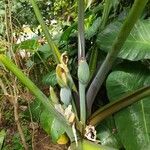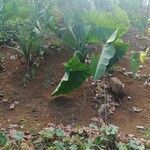Large fleshy herb with underground tuber and in large specimens a short, stout, aerial stem.. Cut tissues exude milky sap.. Leaves rosulate; blade sagittate, up to ± 70 cm. long or more, 50 cm. broad, deep green above, paler and pruinose below with subacute basal lobes, horizontal to slightly pendent (not vertically pendent) from suberect, green to glaucous violet petiole to 100 cm. long or more.. Spathe up to 30 cm. long; tube green, inflated, persistent, up to 8 cm. long; blade longer, creamy white to yellowish buff, erect, deciduous.. Spadix slightly shorter than spathe, lacking sterile appendix.. Flowers unisexual, lacking tepals.





